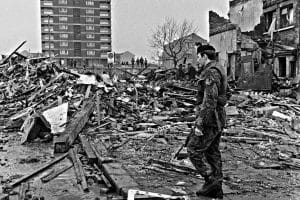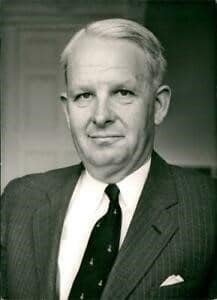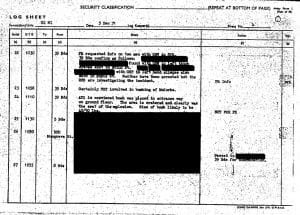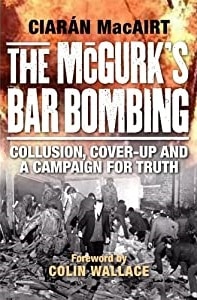Saturday 4 December is the 50th anniversary of the McGurk’s Bar Massacre which, in 1971, was the greatest loss of civilian life in any single murderous attack in Ireland since the Nazi Blitz in 1941.
15 civilians including two children perished in the atrocity when Loyalist extremists planted a no-warning bomb in the hallway of McGurk’s Bar, a family-run pub in north Belfast. The McGurk family lived above their bar. In a split second, Patrick McGurk lost his wife, his only daughter, his brother-in-law, his livelihood and his home. He and his sons thankfully escaped, albeit injured.
I am a grandson of two of the McGurk’s Bar Massacre victims. My grandmother, Kathleen Irvine, was one of the 15 civilians murdered. My grandfather, John, was badly injured but survived. Like the other survivors, he shouldered the physical and mental scars of that night every day until he died 22 years later. He had night terrors and his frightened family sometimes found him pushing the rubble away from himself as he slept or clawing at his mouth as if it had filled with pulverised mortar once again.

An eight-year-old paperboy called Joseph McClory saw the bomber plant the bomb in the hallway and light its fuse. The man ran to a waiting car which then drove off, leaving the young boy behind. Joseph saw a local man about to turn the corner and go into the pub, but he shouted to him, “Mister, don’t go into that bar. There’s a bomb there.”
The eight-year-old saved the man’s life and gave the Royal Ulster Constabulary a detailed statement regarding the attack on the bar and the escape of the bombers. The local man told the police that Joseph had indeed warned him and the bar exploded in seconds after that.
Nevertheless, before we buried our loved ones, the British state buried the truth.
Nevertheless, before we buried our loved ones, the British state buried the truth.
Within hours and before all of the victims had been identified, police, the British Army and government officials briefed the press that the explosion was the result of an Irish Republican Army “own-goal”, to use their heinous language. Instead of trying to bring the pro-state mass murderers to justice, the British state instead blamed the bombing on the innocent civilians in the bar. Their only crime? The victims and survivors were Irish Catholics, and they were living and dying in a rotten, sectarian Orange state.
Proof that the ‘Irish Question’ could not be solved by military and legal means alone came early in the conflict but was not heeded for another generation. Far from quelling what the British portrayed as localised unrest, the introduction of internment on the 9th August 1971 plunged the north of Ireland into an all-enveloping spiral of violence, destruction and death. The story of its failure is told in the death toll in the months prior to and following its introduction. Ten people (four British soldiers, four civilians and two Republican Volunteers) died in the four months leading up to internment. One hundred and twenty eight died in its four-month aftermath (sixty nine civilians and fifty nine combatants – thirteen Republican Volunteers and forty six British army, RUC, UDR and Loyalist personnel).
Before Internment was introduced in August 1971, the British authorities had urged the Northern Ireland Prime Minister Brian Faulkner to include alleged Protestant extremists in the initial lifts. It could then be argued that the Special Powers were not designed to be directed solely against the Catholic community.
Faulkner refused as he knew that he would not have the support of his party or the RUC. Instead, the British authorities formalized an “Arrest Policy for Protestants” (discovered by Pat Finucane Centre) which meant that no Protestants were interned until 1973 even though they had murdered well over a hundred civilians by then. Therefore, if it was admitted to the public that pro-state Loyalists had perpetrated the McGurk’s Bar Massacre on the 4th December 1971, the Northern Ireland government’s assertion to Whitehall that they were “no serious threat” would be completely untenable. As it was, internment without trial remained directed against the Irish Catholic community alone for another 14 months over the bloodiest year of the conflict. Even after that, alleged Protestant extremists only made up 5% of internees even though the Protestant community was around twice the size of the Irish Catholic community in the statelet.
As Village Magazine examined (https://villagemagazine.ie/a-pact-sworn-by-devils-how-a-british-prime-minister-sold-his-soul-to-acquire-votes-to-enable-the-uk-to-join-the-european-economic-community-the-forerunner-of-the-eu/), Edward Heath and the Northern Ireland Prime Minister are in the frame for a sordid Faustian pact which bartered the maintenance of the highly discriminatory internment policy, Unionist votes in favour of the European Economic Community, and the cover-up of the McGurk’s Bar Massacre.
So devastating and all-enveloping was this cover-up, that the victims and survivors of the McGurk’s Bar Massacre were blamed for the attack and their families are still fighting for scraps of truth and justice from the British table half a century later. The Loyalists who murdered them murdered many, many more civilians in the years afterwards although only one served any time whatsoever for the murders. The police had detailed information on them all from a covert human intelligence source relating to the bombing.
The British state had much to bury, though.
The British state had much to bury, though.
We know from secret documents that it undermined Joseph McClory who saw the bomb being planted and the bombers escape. The McClory family received death threats afterwards.
The British authorities ignored the witness testimony of the man he saved and all of the civilians who survived the bombing although they buried corroborating information from a witness at the bomb site the following day.
The British state even ignored a public claim by Loyalists that its members blew up McGurk’s Bar.
We now know too that the police and British Army had information relating to a suspect car within a minute of the explosion. It found and finger-printed what secret police records called the “car used in explosion Gt. George St.” Two prints were recovered but this evidence and the car disappeared until 2011.
We now know too that the police and British Army had information relating to a suspect car within a minute of the explosion. It found and finger-printed what secret police records called the “car used in explosion Gt. George St.” Two prints were recovered but this evidence and the car disappeared until 2011.
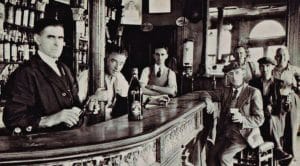
Secret British military logs record British military observation posts on two high-rises overlooking the area, a block of flats nearby, an electrical installation and the major police/army Barracks a stone’s throw away. We now know too that the British Army had a covert “ambush OP” in the area and a foot patrol close to where the bomb car was abandoned.
So, within half a kilometre, McGurk’s Bar was surrounded by British military units although the British Ministry of Defence cannot tell us where its clandestine death squad, the Military Reaction Force, was that night even though we proved that it had been working closely with the resident British Army Battalion nearby in the hours before the explosion.
So, within half a kilometre, McGurk’s Bar was surrounded by British military units although the British Ministry of Defence cannot tell us where its clandestine death squad, the Military Reaction Force, was that night even though we proved that it had been working closely with the resident British Army Battalion nearby in the hours before the explosion.
These same historical investigations by the likes of Police Service Northern Ireland/Historical Enquiries Team and Office of the Police Ombudsman still record to this day that the police and British Army at the time could not even find the seat of the explosion which we found unbelievable.
In 2016, I had to fight the Ministry of Defence, the National Archives and Information Commissioner’s Office at an Information Tribunal for sight of a Headquarters Northern Ireland file I found at Kew.
This proved that an Ammunition Technical Officer (ATO) – a British bomb expert – informed British Army Brigade and HQNI the following morning (5th December 1971) that he was:
“convinced bomb was placed in entrance way on ground floor. The area is cratered and clearly was the seat of the explosion.”
This is exactly where Joseph McClory witnessed the Loyalist plant the bomb and light its fuse.
Nevertheless, in the “Action” column of this log are the words in capitals: “NOT FOR PR”
What this meant was that this obviously critical information was not for press release or for public consumption. Instead, the police peddled the lie that morning:
“Just before the explosion a man entered the licensed premises and left down a suitcase, presumably to be picked up by a known member of the Provisional IRA. The bomb was intended for use on other premises. Before the ‘pick-up’ was made the bomb exploded.”
The British authorities have never told the families the provenance or origin of this egregious lie.
Information is just as much a battlefield today as it was then, so I have devoted much of my adult life in examining the context of the use of words as weapons of war in the north of Ireland.
In my book, The McGurk’s Bar Bombing (Frontline Noir, 2012), I examined British counter-insurgency policy, information policy, the formation of information units and clandestine extra-legal death squads.
General Sir Frank Kitson, then Brigadier of 39 Brigade in charge of Belfast and already a renowned expert on counter-insurgency created, bolstered and managed all of these at the time so he loomed large over my research (https://www.papertrail.pro/podcast-2-general-kitson-pt1/).
The thread that I followed throughout was this heinous state lie that criminalized our loved ones and allowed pro-state mass murderers go free. This meant that I had to unravel and track it back over years from media articles, government speeches, departmental meetings, intelligence reports, RUC Duty Officer reports and Joint Security Committee minutes.
I tracked physical evidence of its existence to within 4 hours and 14 minutes of the explosion.
I discovered a 39 Brigade Commander’s Diary for December 1971 which was closed for 84 years but again I fought for it via the Freedom of Information Act and Public Interest Test.
In it was proof that the Brigade Commander informed Brigade staff at 0100 hours, 5th December:
“RUC have a line that the bomb in the pub was a bomb designed to be used elsewhere, left in the pub to be picked up by Provisional IRA. Bomb went off and was a mistake. RUC press office have a line on it – NI should deal with them”.
This was the earliest record we have discovered of the origin of the lie that criminalized our loved ones and it emanated from a secret agreement between the RUC and British Army. The British Army Commander agreed this “line” and allowed the RUC to manage it.
Who was the Brigade Commander?
None other than Brigadier Frank Kitson. We were right. General Sir Frank Kitson (retired) has his dirty fingerprints all over the McGurk’s Bar cover-up. That is why we demand he is questioned under caution immediately and before he dies.
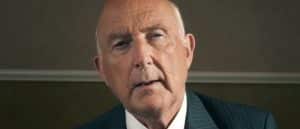
In the excellent appraisal, Kitson’s Irish War, David Burke spoke with Colin Wallace, a former Senior Information Officer who worked with the information policy and psychological operations units at the time. Colin, who also kindly wrote the foreword of my first book, said this of Kitson:
“If I have a criticism of him [Kitson], it relates to the McGurk’s Bar bombing. Why did Kitson, who was no shrinking violet, go along with the cover-up? Why did he not stand up and put a halt to the disinformation? Instead, he ordered the telephone operations room at 39 brigade to direct queries to the RUC who were promoting the IRA own-goal fabrication”
To this day, Police Service Northern Ireland, the Office of the Police Ombudsman, Ministry of Defence, and the Cabinet Office have denied me access to the record of this secret agreement between the RUC and Frank Kitson. Each one of them have also denied me proof and provenance of the RUC “line” which we know, of course, was a lie and one that was created by the British state. Agreed by by the British armed forces just hours after the horrific atrocity, the damage that this collusion caused to our families for generations is unfathomable.
But it looks like the British authorities today will help Frank Kitson escape justice.
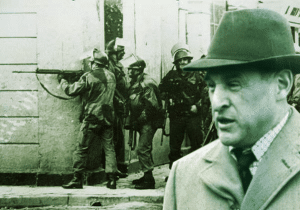
Further Information for interested readers:
The McGurk’s Bar Bombing Post-Script: https://mcgurksbar.com/wp-content/uploads/2020/10/McGurks-Bar-Post-Script-Final-Redux.pdf
The McGurk’s Bar Bombing and the Plot to Deceive Two Parliaments https://mcgurksbar.com/wp-content/uploads/2020/12/The-McGurks-Bar-Bombing-and-the-Plot-to-Deceive-Two-Parliaments-Report-Redux.pdf

